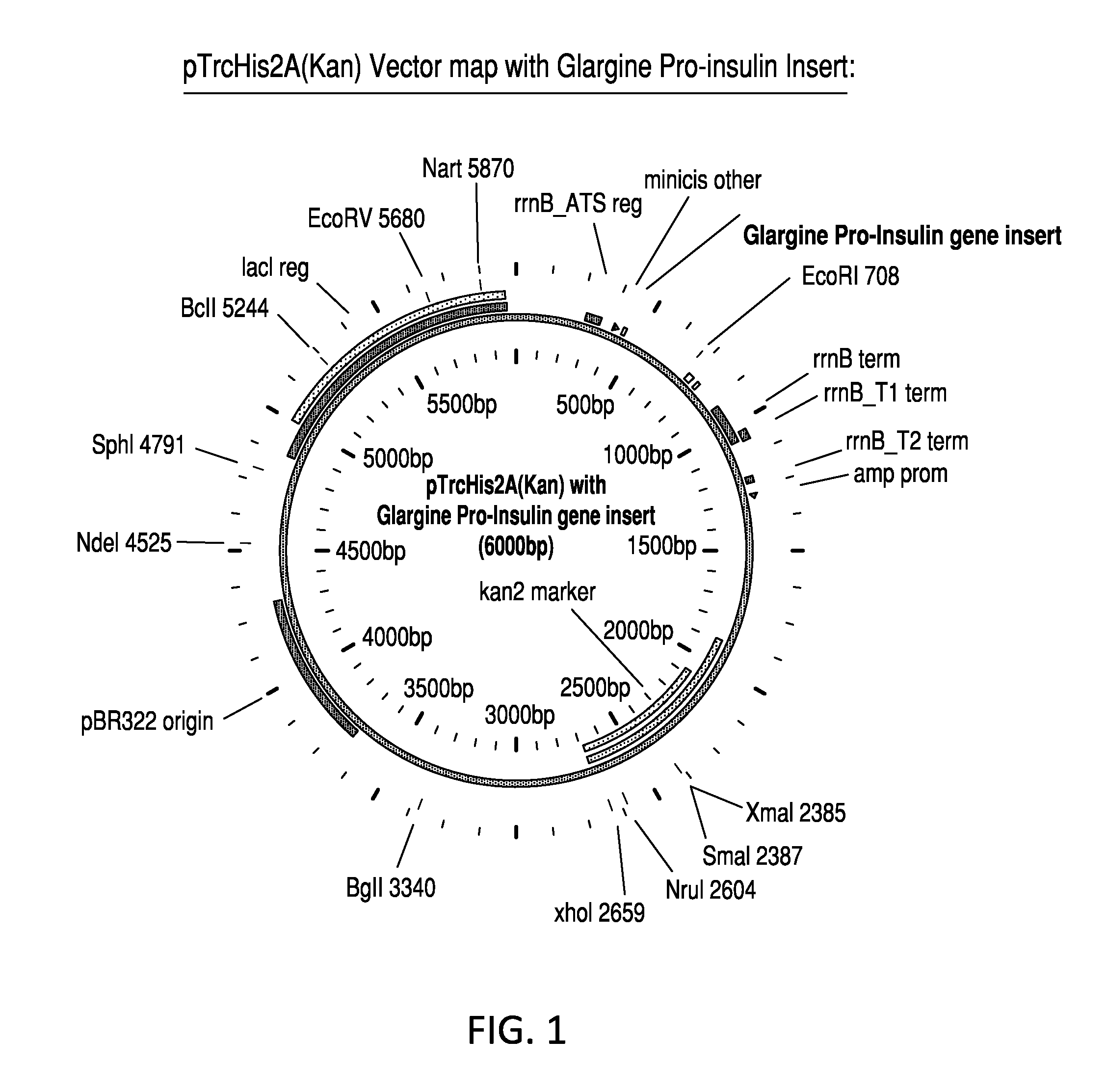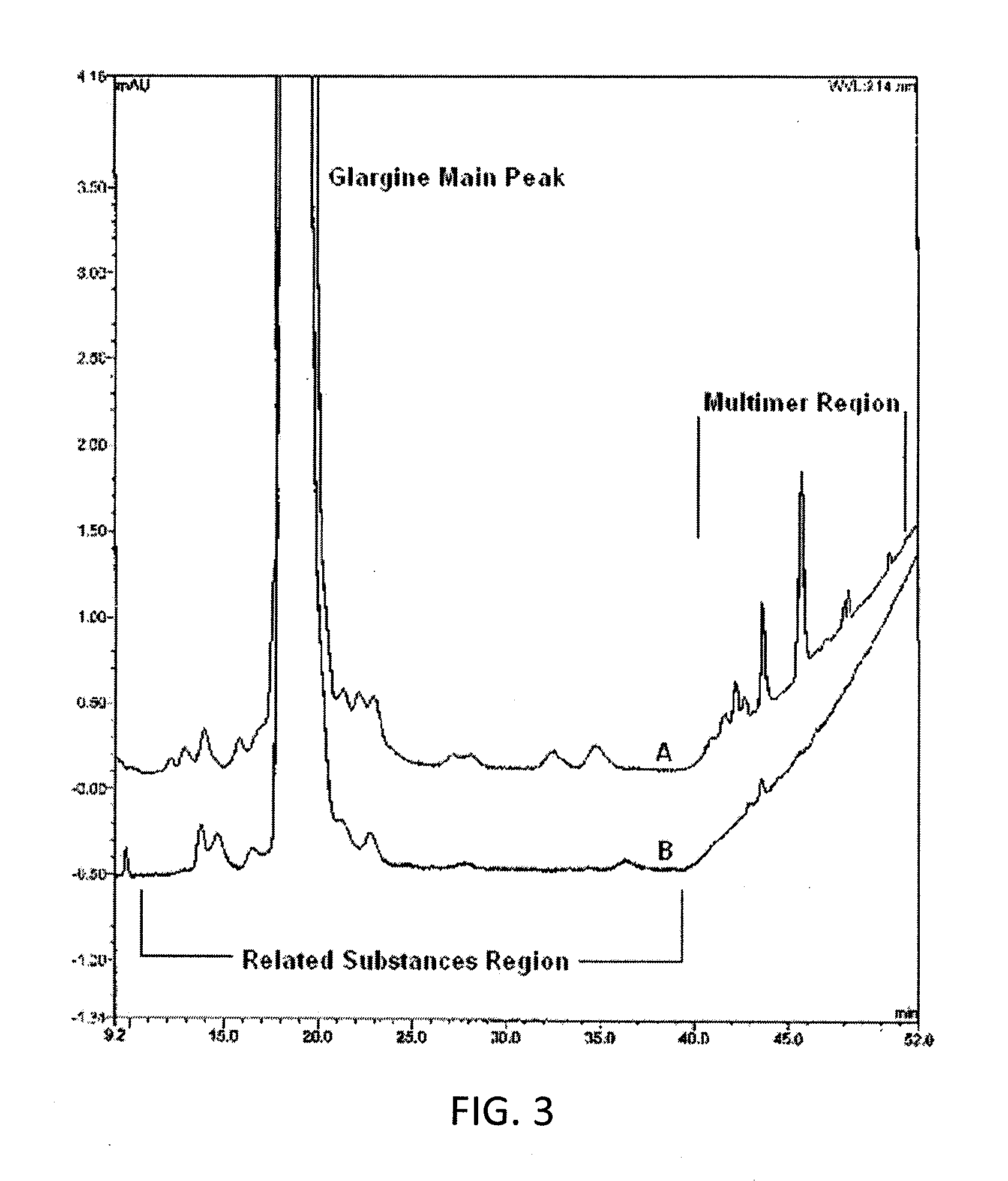Glargine proinsulin and methods of producing glargine insulin analogs therefrom
a technology of glargine proinsulin and glargine peptide, which is applied in the field of glargine proinsulin and methods of producing glargine insulin analogs therefrom, can solve the problems of low insulin yield, entail the inconvenience of using laborious purification steps, and the yield of refolded proinsulin having correctly folded disulfide bonds
- Summary
- Abstract
- Description
- Claims
- Application Information
AI Technical Summary
Benefits of technology
Problems solved by technology
Method used
Image
Examples
example 1
Preparation of an E. coli Clone Expressing Glargine Proinsulin
[0086]The preparation of transformed E. Coli containing cells capable of expressing recombinant glargine proinsulin is carried out according to the following processes. In addition, a cell bank of the transformed E. Coli is also described.
[0087]Step 1: Construction of a purified glargine proinsulin gene segment for insertion into the vector. The initial gene construct was synthesized in a basic cloning vector. The gene construct included the N-terminal histidine tag, MHHHHHHGGR (SEQ ID NO: 4), modified B-chain, and modified C-peptide with the alanine codon in place of the native lysine and having the amino acid sequence MHHHHHHGGRFVNQHLCGSHLVEALYLVCGERGFFYTPKTRREAEDLQVGQVELGGG PGAGSLQPLALEGSLQARGIVEQCCTSICSLYQLENYCG (SEQ ID NO: 16). The gene was flanked by Nde1 and EcoR1 restriction sites, for subsequent subcloning into the desired expression vector. The codons selected were optimized for expression in E. coli. The follow...
example 2
Product Manufacture of Glargine Insulin Analog from Modified Proinsulin Sequence
[0097]Step 1—Culturing of E. coli transformed with glargine modified proinsulin sequence from the WCB of Example 1. Seed an inoculum preparation of the WCB in a sterile growth medium that includes yeastolate (purchased from VWR, Prod. #90004-426 or -488), select phytone, sodium chloride, purified water, sterile Kanamycin solution), and incubate until growth to an Optical density (OD600 nm) of 2 to 4. Prepare a fermentation media (containing select phytone, yeastolate, glycerin, BioSpumex 153K (Cognis, Inc.) in a fermentor. Add the following sterilized phosphate solutions to the Fermentor. Prepare a Phosphate flask 1—potassium phosphate monobasic and potassium phosphate dibasic containing Kanamycin solution. Prepare a Phosphate flask 2—potassium phosphate monobasic and potassium phosphate dibasic. Add seed inoculate of E. coli to the Fermentor—growth to O.D. (optical density) 600 nm of 8 to 10 (mid log ph...
example 3
Final Purification
[0107]Step 11—Ion Exchange Chromatography—The digested material is loaded onto a cation exchange column and eluted with a NaCl gradient, in the presence of 20% n-propanol or acetonitrile at pH 2-5, preferably 4.0. RP-HPLC is used to pool the appropriate fractions containing the Glargine insulin peak of interest at the desired purity level.
[0108]Step 12—Reverse Phase Chromatography—The S-column pool containing the Glargine insulin is loaded onto an RPC30 or C18 reverse phase column and eluted using an n-propanol or acetonitrile gradient in the presence of 200 mM sodium sulfate and 0.136% phosphoric acid. Fractions are immediately diluted 1:4 with water if n-propanol is used for elution; or 1:2 with water if acetonitrile is used for elution, or no dilution if acetonitrile is used for elution. RP-HPLC is used to pool the appropriate fractions containing the glargine insulin peak of interest at the desired purity level.
[0109]Step 13—Buffer Exchange—Exchange the sample ...
PUM
| Property | Measurement | Unit |
|---|---|---|
| composition | aaaaa | aaaaa |
| width | aaaaa | aaaaa |
| nucleic acid sequence | aaaaa | aaaaa |
Abstract
Description
Claims
Application Information
 Login to View More
Login to View More - R&D
- Intellectual Property
- Life Sciences
- Materials
- Tech Scout
- Unparalleled Data Quality
- Higher Quality Content
- 60% Fewer Hallucinations
Browse by: Latest US Patents, China's latest patents, Technical Efficacy Thesaurus, Application Domain, Technology Topic, Popular Technical Reports.
© 2025 PatSnap. All rights reserved.Legal|Privacy policy|Modern Slavery Act Transparency Statement|Sitemap|About US| Contact US: help@patsnap.com



